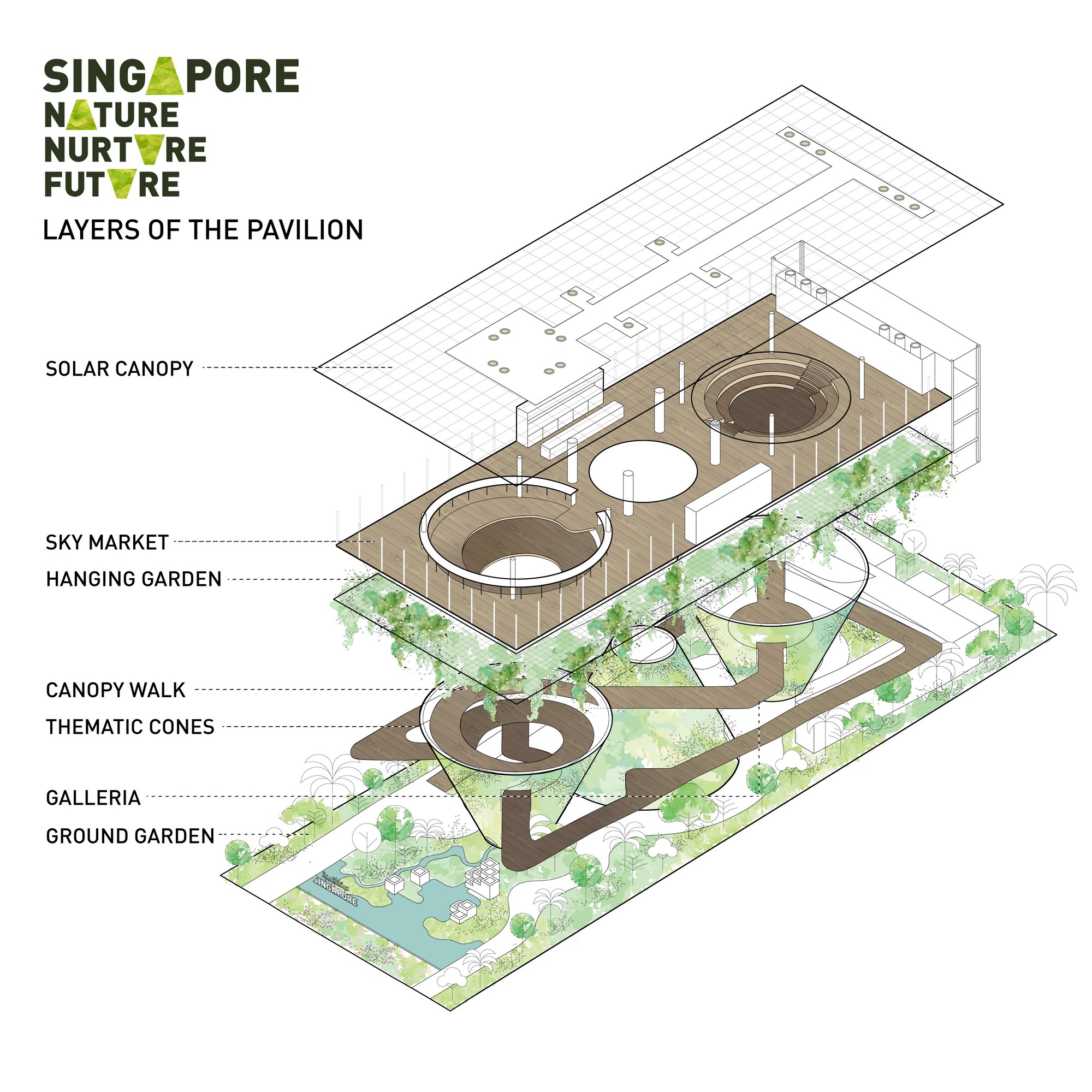WOHA was appointed to design the Singapore Pavilion for the Expo 2020 Dubai by the Urban Redevelopment Authority, Singapore’s land use planning and conservation agency. The Expo is set to open its doors to the public on 1 October 2021, and construction of the Singapore Pavilion is almost completed. It is located in the Expo’s Sustainability District and is inspired by the theme ‘Nature. Nurture. Future.’ in the form of a lush oasis in the desert.
To maximise and multiply usable area, the design takes a layered approach, stacking multiple levels and functions on top of each other. On the ground level, visitors are greeted by verdant palms, trees, shrubs and vibrant orchids. They are covered by a spectacular Hanging Garden and anchored by three thematic cones that are draped in vertical greenery, to form a voluminous, 3-dimensional and layered green space. The cones are topped with the Open Sky Market platform, a space for congregation and engagement, which is sheltered by a solar canopy – shading the pavilion from the sun and generating electricity at the same time.
The Pavilion operates entirely on solar energy and solar desalination systems, maintaining a net-zero energy footprint over the 6-month Expo period. It uses passive strategies like natural cross ventilation, sun-shading and planting to create a comfortable climate for visitors to enjoy and plants to thrive in. The planting is well underway and from now until the opening of the Expo the greenery will adjust and grow even more lush. Beyond creating a biophilic environment, the plants provide important ecosystem services like solar heat reduction, sequestration of greenhouse gases, reduction of other pollutants such as PM10 particles, oxygen production, rainwater remediation as well as providing habitats for animals.
“The Singapore Pavilion is a prototype that shows how we can build resilient, self-sufficient, biophilic, friendly yet highly functional structures that co-exist with nature. It provides measurable ecosystem services and can be adapted to suit different climates, geographies and can be scaled up to district or even city levels” says Wong Mun Summ, co-founding Director of WOHA. “If we build a significant amount of structures that use a similar design approach as the Singapore Pavilion, we could make a meaningful impact on climate change.”
Environmental consultants BioSEA have projected that the plants enable a solar heat reduction that saves 70% worth of air-conditioning energy consumption compared to an enclosed space of the same floor area. It provides oxygen for 150 people per year and sequesters 61 tonnes of carbon dioxide in its lifespan. This is the equivalent of 66 flights between Dubai and Singapore. Nitrogenoxide compounds are critical pollutants found in emissions from all types of internal combustion engines. The Pavilion sequesters 177g of nitrogen-oxide compound emissions in a year, which is equivalent to driving 117km in a Euro 5 Diesel car. The plants of the Pavilion also remove microscopic PM10 particles from the air, performing at the same level 2,385 sqm of Dubai’s natural forest vegetation would. Finally, the Pavilion saves 11,000 litres of water runoff when compared to the planting of a typical bungalow in Dubai.
A total of 517 solar panels on the roof canopy not only generate electricity but also shade the Pavilion from the sun and protect it from the elements. The solar canopy will generate 161 MWh over its 6-month operation period, enough to power 70 standard households in Singapore for half a year. The water desalination system treats 40 m3 of water per day which is used to irrigate the plants and operate the Pavilion.
The Singapore Pavilion is a prototype that could be scaled up and adapted to different climate zones. It demonstrates the great potential of the respectful, seamless integration and co-existence of nature and architecture and presents a captivating and forward-looking Singapore, one that is sociable, sustainable and livable.







3 Comments
Jazz Music
(November 12, 2023 - 12:38 pm)Jazz Music
Jazz Music
relaxing jazz music
(November 29, 2023 - 1:34 pm)relaxing jazz music
relaxing jazz music
spring
(January 18, 2024 - 12:59 am)spring
spring
Comments are closed.